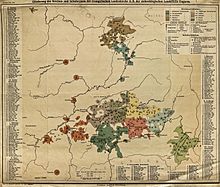Evangelical Church of Augustan Confession in Romania
show This article may be expanded with text translated from the corresponding article in Romanian. (August 2021) Click [show] for important translation instructions. |
| Evangelical Church of the Augsburg Confession in Romania | |
|---|---|
| Evangelische Kirche Augsburgischen Bekenntnisses in Rumänien (de) Biserica Evanghelică de Confesiune Augustană în România (ro) | |
 | |
| Abbreviation | BECAR |
| Type | Western Christianity |
| Classification | Protestant |
| Orientation | Lutheranism |
| Scripture | Bible |
| Theology | Confessional Lutheranism |
| Polity | Episcopal |
| Bishop | Reinhart Guib |
| Districs | 5 |
| Associations | |
| Region | Romania |
| Language | German, Romanian |
| Headquarters | Str. General Magheru nr.4, Sibiu |
| Founder | Johannes Honter |
| Origin | 1540s |
| Separated from | Roman Catholic Church |
| Congregations | 254 |
| Members | 14,543 (2008) |
| Pastors | 44 |
| Tertiary institutions | Protestant Theological Institute of Cluj |
| Official website | evang |
The Evangelical Church of Augsburg Confession in Romania (German: Evangelische Kirche A.B. [Augsburgischen Bekenntnisses] in Rumänien, Romanian: Biserica Evanghelică de Confesiune Augustană în România) is a predominantly German-speaking Lutheran church in Romania, mainly based in Transylvania. As a Lutheran church, it adheres to the Augsburg Confession. Its history goes back to the 12th century when the Transylvanian Saxons arrived in the region, then part of the Kingdom of Hungary.[1]
The church has close ties to, but is distinct from, the Evangelical Lutheran Church of Romania, which is mainly Hungarian-speaking. It also cooperates with the Calvinist Reformed Church in Romania.[2]
History[]
This section needs expansion. You can help by . (August 2021) |
Beginnings[]
The history of the Evangelical (Lutheran) Church in the territory of today's Romania finds its beginnings in the mid-16th century, through the humanist cartographer and reformer Johannes Honterus.[3] Martin Luther's writings had been brought and spread in Transylvania as early as 1519, but the real reformation among the German Catholic population took place in 1542 (or 1543) with the publication of Reformationsbüchlein by Honterus in his own printing house in Brașov.[4]
In 1572, the Synod of Mediaş accepted the "Augustan Confession", one of the most important doctrinal documents of Lutheranism (presented in 1530 in Augsburg), as the basis for preaching and church life.[3]
In the semi-independent Principality of Transylvania (under Turkish control), the church enjoyed much religious freedom.[2] However this changed when it came under Habsburg control, with the Catholic Church having privileged status.[3]
20th century[]

The Lutheran German minority was highly persecuted during the communist era. The church activities were surveyed by the Securitate, its school system and the diaconal institutions were dismantled and some priests were arrested and even sent to labor camps (most notably Richard Wurmbrand). This resulted in an increasing emigration of members. After the 1989 revolution (and the opening of the borders), many Germans left the country, which decimated the number of members in the church.[2]
Churches[]

One of the Lutheran fortified churches in Biertan

Lutheran Church, Bucharest

Saint Bartholomew Church, Brașov
References[]
- ^ "Archived copy". Archived from the original on 2008-10-13. Retrieved 2009-11-27.CS1 maint: archived copy as title (link)
- ^ Jump up to: a b c "World Council of Churches: Evangelical Church of the Augsburg Confession in Romania".
- ^ Jump up to: a b c "Secretariatul de stat pentru culte: Biserica Evanghelică C.A. din România" (in Romanian).
- ^ (Latin: "Reformatio ecclesiae Coronensis ac totius Barcensis provinciae" (1543), German: "Reformationsbüchlein für Kronstadt und das Burzenland", Romanian: "Cărticica de reformă pentru Brașov și Țara Bârsei")
External links[]
- Official website (in German and Romanian)
- Lutheranism in Romania
- Religious organizations established in the 1570s
- Lutheran World Federation members
- Lutheranism stubs
- Christian denomination stubs
- Romania stubs







